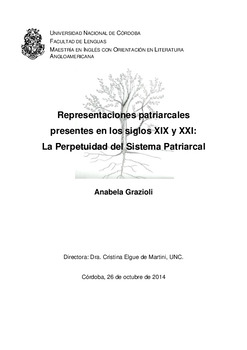| dc.contributor.advisor | Elgue de Martini, Cristina | |
| dc.contributor.author | Grazioli, Anabela | |
| dc.date.accessioned | 2016-04-12T13:50:54Z | |
| dc.date.available | 2016-04-12T13:50:54Z | |
| dc.date.issued | 2014 | |
| dc.identifier.uri | http://hdl.handle.net/11086/2554 | |
| dc.description.abstract | The cinema is an important part of people’s everyday lives, and it contributes to influence our perception of the world and of ourselves as subjects. A vast amount of research has been made on gender representations in the cinema, but it could still result startling to establish parallelism between gender representations in twenty-first-century films and in a classic nineteenth-century novel. A careful analysis could explain particular social processes that could account for the perpetuity of patriarchy, and the results could suggest that the patriarchal system adapts itself throughout time, and does not lose its hegemony in the construction of social identity. With the purpose of enquiring about parallels between gender representations, a first analysis will be necessary in order to observe whether the films Bridget Jones’ Diary and Bridget Jones’ Diary: the Edge of Reason could be considered a parody of the classic nineteenth-century novel by Jane Austen, Pride and Prejudice, and the way ironic inversion marks the critical difference between them. | es |
| dc.language.iso | eng | es |
| dc.rights | Atribución-NoComercial-SinDerivadas 2.5 Argentina | * |
| dc.rights.uri | http://creativecommons.org/licenses/by-nc-nd/2.5/ar/ | * |
| dc.subject | Patriarcado | es |
| dc.subject | Siglo XIX | es |
| dc.subject | Siglo XXI | es |
| dc.subject | Estudio de género | es |
| dc.title | Representaciones patriarcales presentes en los siglos XIX y XXI : la perpetuidad del sistema patriarcal | es |
| dc.type | masterThesis | es |





